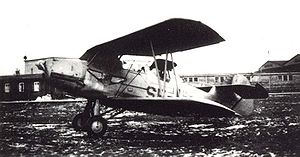Arado Ar 66 Video - Picture

|
|
Arado Ar 66

Role: Trainer
Manufacturer: Arado
Designer: Walter Blume
First flight: 1932
Introduction: 1933
Primary user: Luftwaffe
The Arado Ar 66 was a German single-engined, two-seat training biplane, developed in 1933. It was also used for night ground-attack missions on the Eastern Front. It was engineer Walter Rethel's last design in collaboration with Arado.
Design and development
Arado's chief designer Walter Rethel started design of a new two-seat trainer in 1931, with the design being developed by Walter Blume when Rethel transferred to Messerschmitt, with the first prototype, the Ar 66a flying in 1932 .
The Ar 66 had an Argus As 10 air-cooled inverted V8 engine producing about 179 kW (240 hp), which drove a 2.5 m (8.2 ft) two-blade propeller. It carried 205 L (54 US gal) of fuel, and 17 L (4 US gal) of oil.
The fuselage had an oval cross-section and was made of welded steel tubes, covered with fabric. The double wings provided very high lift, even at low speeds. Both wings had the same span and an 8° sweep. Construction consisted of a double pine cross-beam structure, with lime tree ribs, and fabric covering. There were ailerons in both upper and lower wings. The tail had a conventional design, with the horizontal stabilizer mounted on the fuselage upper edge. The rudder was placed behind the elevator. Both the rudder and the elevator were of steel tube covered in fabric, and had a bigger surface than the first version to correct balance problems. The steel tube undercarriage was attached to the fuselage in a "V" shape and used a high-pressure rubber suspension.
The crew consisted of two: instructor pilot and trainee, seated in open tandem cockpits equipped with dual controls. The aircraft was equipped with instrument flight systems with photographic cameras were mounted as optional equipment.
Operational history
The Ar 66 entered service with the Luftwaffe in 1933, serving as a trainer until well into World War II. In 1943, the Luftwaffe set up a number of night harassment groups to operate on the Russian front. The Ar 66, along with the Gotha Go 145, formed the main equipment of these groups.
Variants
Ar 66A
Used in the new Luftwaffe as a trainer.
Ar 66C
Modified elevators, larger rudder, and larger-diameter wheels.
Ar 66B
Seaplane version of Ar 66C. Two large steel hollow floats braced with iron cable. About 10 were constructed and used for seaplane training.
Operators
Germany
Luftwaffe
Nachtschlachtgruppe 2
Nachtschlachtgruppe 3
Nachtschlachtgruppe 5
Nachtschlachtgruppe 8
Nachtschlachtgruppe 12
Specifications (Ar 66C)
Data from German Aircraft of the Second World War
General characteristics
Crew: Two
Length: 8.3 m (27 ft 2¾ in)
Wingspan: 10 m (32 ft 9¾ in)
Height: 2.93 m (9 ft 7â…“ in)
Wing area: 29.6 m² (319 ft²)
Empty weight: 905 kg (1,996 lb)
Loaded weight: 1,330 kg (2,993 lb)
Powerplant: 1 x— Argus As 10 C eight-cylinder air cooled inverted V-8 engine, 179 kW (240 hp)
Performance
Maximum speed: 210 km/h (130 mph)
Cruise speed: 175 km/h (109 mph)
Range: 716 km (389 nmi, 445 mi)
Service ceiling: 4,500 m (14,800 ft)
Climb to 1,000 m (3280 ft): 4.1 min
Landing Speed: 80km/h (50 mph)
Armament
2 kg (4.4 lb) and 4 kg (8.8 lb) anti-personnel bombs
Arado Flugzeugwerke
Smith, J.R and Kay, Antony L. German Aircraft of the Second World War. London: Putnam, 1972. ISBN 0-85177-836-4.
Arado Ar 66 Pictures
More airplane video.
Source: WikiPedia